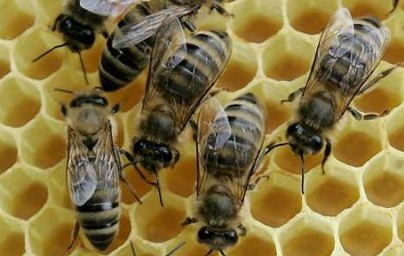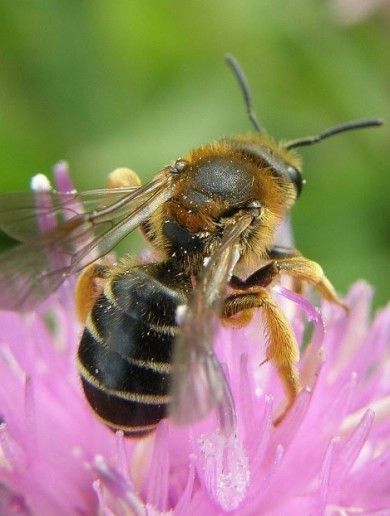CRAB BEEHIVES CELTIC CUISINE (2)
Oengus in the entry in his Féilire:
“In a little boat from the east over the pure-coloured sea,
my Domhnoc brought …
the gifted race of Ireland’s bees.”
 This relation of our famous Columcille (who set up the monastery in Kells) Modomnoc, or “our precious Dominic”, was said to have brought bees to Ireland. We are glad to have bees – without them the planet would not work.
This relation of our famous Columcille (who set up the monastery in Kells) Modomnoc, or “our precious Dominic”, was said to have brought bees to Ireland. We are glad to have bees – without them the planet would not work.
Before we get started – with the launch of the Biodiversity plan for Kells last week, and the launch of Ireland’s Ancient Eats this coming September, nature is much in our minds, and the importance of bees in our ancient Monastery and all over Ireland.
In old times, the management of bees was universally understood, and many householders kept bees in their gardens.
The monks were great bee-keepers and the monastery in Kells was no exception. Possibly where the bees were kept was close to the Carrick Street side of the monastery.
So important were bees, that the High King Cormac mac Airt, the Lawgiver, who moved his royal residence to Kells, assured that bees were enshrined in the Irish law system, the Brehon Law.
The Bee-Judgements occupied around 20 pages of the Brehon Law tract. In Irish the name for bee is “beacha” and a hive is “coirceog”. For example, if a man or woman found a coirceog in the green surrounding and belonging to a house, a quarter of the produce to the end of a year was due to the finder, and the remaining three quarters to the owner of the house.
Further in the Law – if the finder came across the coirceog in a waste land not belonging to an individual, but the common property of the tribe, the bees and honey belonged to the finder, except one-ninth to the chief of the tribe.
And so on. The Law was very specific.
 And for newlyweds – what better place to honeymoon than in Ireland? In Gaelic, “honeymoon” is “mi na meala,” meaning “the month of honey.” The newlyweds celebrated their wedding by drinking mead (made out of fermented honey) for a month.
And for newlyweds – what better place to honeymoon than in Ireland? In Gaelic, “honeymoon” is “mi na meala,” meaning “the month of honey.” The newlyweds celebrated their wedding by drinking mead (made out of fermented honey) for a month.
During the Battle of Kells Medieval Fayre in August 2016, the Druid Chef, Rory Morahan, will bring the culinary past of the ancient alive through his open fire cookery. The art of cooking with honey through basing glazing sweetening and flavour will be show at his culinary Cauldron. Honey is major indigenous ingredient use by the druid chef which will be demonstrated through his Celtic Cuisine.
Now- back to the relative of Columcille – the writings tell us that a young man named Modomnoc – “our precious Dominic” – who was a descendant of the royal line of O’Neil went to be educated under Saint David at Mynyw (Menevia, now Saint David’s) Monastery in Wales. He was given charge of the bees and he loved it and cared for the bees tenderly, keeping them in straw skeps in a special sheltered corner of the garden, where he planted the kinds of flowers the bees loved best. He talked to the bees as he worked.
The honey for that monastery flourished, thanks to Modomnoc and his bees. Neither did they run out of mead.
When Modomnoc completed his studies and was to return to Ireland, he said good-bye to the Abbot, the monks, his fellow students- and the bees. After boarding the ship – and 3 miles from shore, Modomnoc saw what looked like a little black cloud in the sky in the direction of the Welsh coast. He watched it curiously and as it came closer, he saw to his amazement that it was a swarm of bees. It was a gigantic swarm – all the bees from all the hives in the monastery garden had followed him!
Modomnoc had to ask the sailors to turn the boat back for Wales, and the abbot and the monks were very surprised to see him back. As he explained what happened, the bees made straight for their hives and settled down. “Wait until tomorrow,” advised the abbot, “but don’t say goodbye to the bees. They will be over the parting by then.”
Twice this happened – and finally the abbot gave Modomnoc the bees. He said “Take them with my blessing. I am certain they would not thrive without you. Take them. We’ll get other bees for the monastery.”
Once back in Ireland, Modomnoc set up a church at Bremore, near Balbriggan in County Dublin and set up the bees in a pleasant garden similar to the one in Wales. To this day, the place is known as “the Church of the Beekeeper.”
So it seems that the bees chose to come to Ireland – let’s protect them and make a safe habitat for them here! The All-Ireland Pollinator Plan 2015-2020 is a good read and has suggestions how we can all be local bee saints and provide safe habitats for these most important members of our planet.
Chef Rory Morahan has given us a special recipe “Beehive Crab with Irish Honey Dressing” for your delectation.
With thanks to Tiarnan de Hal and Rory Morahan.
Loved this post, Lucy! I too have written about bees in Irish mythogy on my blog, and also mead. The Druid Chef sounds interesting!
Another great post Lucy – love the way you link the past to the present with information on the All Ireland Pollinator plan – here’s to more “local bee saints”!